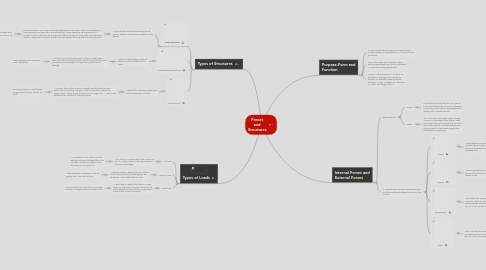
1. Types of Loads
1.1. Live load
1.1.1. A live load is a moving object that moves on top of a certain object. It is using a dynamic load as an advantage.
1.1.1.1. An example of a live load is: humans walking, trucks on a bridge, bikes on a mountain, erasers on a table, and a basketball on the gym floor.
1.2. Dynamic load
1.2.1. A dynamic load is a external force or a force that is natural this force reacts against the dead load. It also effects the live load.
1.2.1.1. A few examples of a dynamic load are: gravity, wind, rain, hail, and ice.
1.3. Dead load
1.3.1. A dead load is a object that holds a moving object on top of it. And carries it around and can withstand the force of the moving object and a certain amount of weight.
1.3.1.1. A few examples of a dead load is: a bridge, a elevator, a freight container, and the floor.
2. Purpose,Form and Function
2.1. Purpose its what the structure was made for like a houses purpose is to get shelter or a turtle shell is for protection.
2.2. Form is the shape of a structure. Form is also the way something is built to withstand a force that is acting against itself.
2.3. Function is the purpose of a function. So that there is a purpose for everything whether it is the Eiffel Tower for tourist attraction. Or the CN tower as a attraction or a store and things inside it.
3. Types of Structures
3.1. Frame Structure
3.1.1. a rigid structure formed of relatively slender pieces, joined so as to surround sizable empty spaces
3.1.1.1. Frame structures use a frame or skeleton that support each other. The human skeleton is a frame structure and even other animals skeleton. Some examples are a goalie’s net, a window and chairs that can be very strong if their parts support each other and help resist forces. A single part of a frame structure cannot support the mass of the structure by itself.
3.1.1.1.1. Examples of frame structures are a house, the Eiffel Tower,a fence, etc
3.2. Shelled/Hollow Structures
3.2.1. There is a hollow space inside, no frame or a structure that isn't fill inside.
3.2.1.1. A shell structure is a structure with a hollow, curved shape. A cave a pop can, and a bike helmet. are all shell structures. Shell structures can be very light, and yet have a great deal of strength.
3.2.1.1.1. Some examples are caves, box, shell, helmet etc
3.3. Solid Structure
3.3.1. Inside of the structure is filled up or without openings or breaks
3.3.1.1. A concrete floor, statue and even a weight are all solid structures. A solid structure is strong, relying on solid construction materials to support loads. Large, strong structures have a large mass. A well-made solid structure can last for a very long time.
3.3.1.1.1. some examples are a solid bridge, the great wall of china, statues and more.
4. Internal Forces and External Forces
4.1. External forces
4.1.1. Gravity
4.1.1.1. This is the force that pulls us to the ground so we are not floating in the air. An example is when the pitcher pitcher the baseball and gravity pulls it towards the bat.
4.1.2. Friction
4.1.2.1. This is the force that keeps us from sliding around and keeping us from falling. When we create friction most of the time we like to stick to the ground no matter what you are doing unless it is figure skating and jump role and you are jumping.
4.2. An internal force is a force that works in you. It is the force theatre allows us to move, twist and turn.
4.2.1. Torsion
4.2.1.1. Is what allows us to twist in all types of ways whether figure skating, golfing, playing soccer or dancing this is used in our everyday lives.
4.2.2. Tension
4.2.2.1. When our body tenses up, normally when we are scared and don't know what to do, afraid, or sad.
4.2.3. Compression.
4.2.3.1. Our body is like a spring. Which allows us to jump, do stretches, do gymnastics and bend when playing hockey or we are skating so we can move quicker and smoother.
4.2.4. Shear
4.2.4.1. When our body feels like it is tearing or we are extending our arms or limbs. It helps up learn to move more elegantly and freely.

